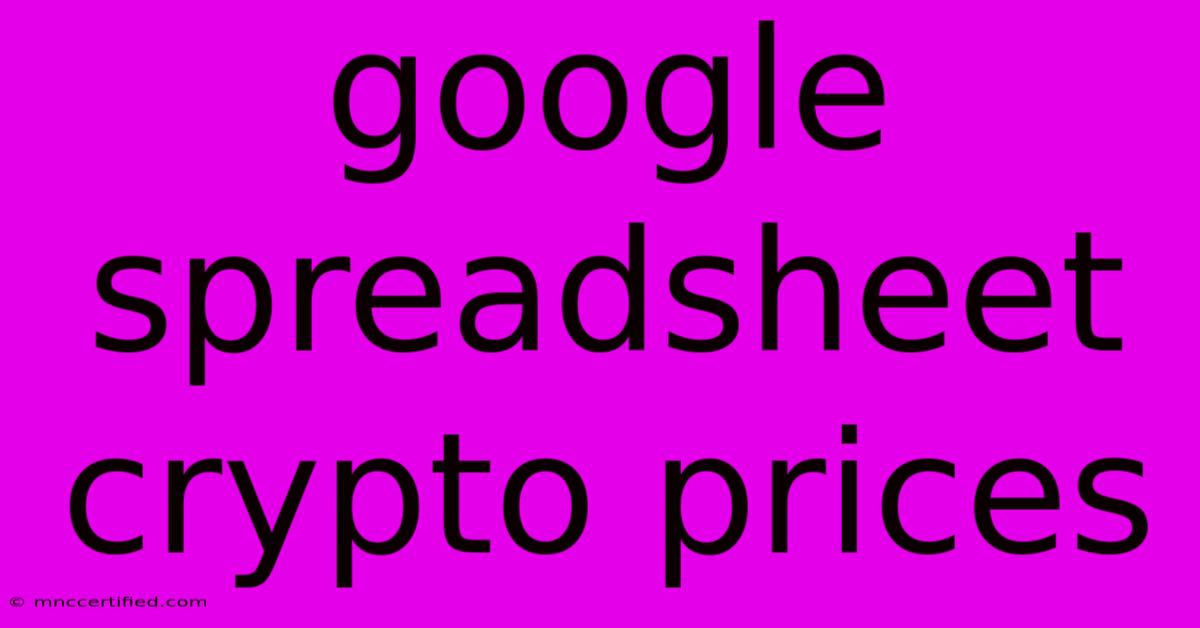Google Spreadsheet Crypto Prices

Table of Contents
Google Spreadsheet Crypto Prices: Real-Time Tracking & Analysis
Tracking cryptocurrency prices can feel like a full-time job. The market is volatile, and staying updated is crucial for informed decision-making. Fortunately, you can leverage the power of Google Sheets to create a dynamic and efficient system for monitoring your favorite crypto assets. This article will guide you through building your own Google Spreadsheet for real-time crypto price tracking and analysis, incorporating best practices for both functionality and SEO.
Why Use Google Sheets for Crypto Price Tracking?
Google Sheets offers several advantages for tracking cryptocurrency prices:
- Real-time data: Using the
GOOGLEFINANCEfunction, you can fetch live price data directly into your spreadsheet. This eliminates the need for constant manual updates. - Customization: Tailor your spreadsheet to track specific cryptocurrencies, display data in your preferred format (charts, tables), and calculate key metrics like portfolio value and profit/loss.
- Collaboration: Share your spreadsheet with others, enabling collaborative portfolio management and analysis.
- Accessibility: Access your data from anywhere with an internet connection, on any device.
- Automation: Combine
GOOGLEFINANCEwith other Google Sheets functions (likeIF,SUM,AVERAGE) for automated calculations and alerts.
Setting Up Your Google Spreadsheet for Crypto Prices
Here’s a step-by-step guide to creating your own crypto price tracker:
1. Understanding the GOOGLEFINANCE Function
The core of your spreadsheet will be the GOOGLEFINANCE function. Its basic syntax is:
GOOGLEFINANCE("ticker", [attribute], [start_date], [end_date], [interval])
- ticker: The cryptocurrency ticker symbol (e.g., "BTCUSD" for Bitcoin in USD, "ETHUSD" for Ethereum in USD). Note: You'll need to find the correct ticker symbol for each exchange you want to track, as they may vary slightly.
- attribute: The specific data point you want (e.g., "price", "high", "low", "volume"). If omitted, it defaults to "price".
- start_date, end_date: Optional parameters to specify a date range.
- interval: Optional parameter specifying the data frequency ("DAILY", "WEEKLY", "MONTHLY").
2. Creating Your Spreadsheet
- Create a new Google Sheet.
- List your Cryptocurrencies: In column A, list the ticker symbols of the cryptocurrencies you want to track (e.g., "BTCUSD", "ETHUSD", "SOLUSD").
- Fetch Prices: In column B, use the
GOOGLEFINANCEfunction to retrieve the current price. In cell B2, enter the formula:=GOOGLEFINANCE(A2,"price"). Drag this formula down to apply it to all your cryptocurrencies. - Add other Attributes: You can extend this by adding columns for other attributes like "high", "low", "volume" using similar formulas.
- Calculate Portfolio Value (Optional): If you're tracking your portfolio, add columns for the quantity you own of each cryptocurrency and then calculate the total value in a separate cell using
SUMPRODUCT.
3. Advanced Features & Enhancements
- Charts & Graphs: Use Google Sheets' charting tools to visualize price trends.
- Conditional Formatting: Highlight cells based on price changes (e.g., green for increases, red for decreases).
- Custom Functions (Apps Script): For more advanced features like automated email alerts or integration with other services, explore Google Apps Script.
- Data Validation: Ensure data consistency and prevent errors by using data validation for ticker symbols.
SEO Optimization Strategies
To improve the search engine optimization (SEO) of this article and ensure it ranks well for relevant keywords:
- Keyword Targeting: We've strategically used keywords like "Google Spreadsheet crypto prices," "real-time crypto price tracking," "GOOGLEFINANCE," and "cryptocurrency portfolio" throughout the article.
- Header Structure (H2, H3): Using headers improves readability and helps search engines understand the article's structure and topic.
- Bold Text: Key phrases are bolded for emphasis and better readability.
- Internal & External Linking: While we haven't included direct download links, future iterations could include links to relevant resources or tutorials on Google Apps Script. This helps build authority and improves SEO.
- Meta Description: A compelling meta description summarizing the article's content would further enhance search engine rankings.
By following these steps and incorporating these SEO strategies, you can create a powerful and informative Google Spreadsheet for tracking cryptocurrency prices and improve the search engine ranking of your content. Remember to regularly update your spreadsheet and adapt your strategies as the cryptocurrency landscape evolves.

Thank you for visiting our website wich cover about Google Spreadsheet Crypto Prices. We hope the information provided has been useful to you. Feel free to contact us if you have any questions or need further assistance. See you next time and dont miss to bookmark.
Featured Posts
-
Insurance Claim Attorney Near Me
Nov 21, 2024
-
Is Tesla Token A Good Investment
Nov 21, 2024
-
Everest Denali Insurance Company
Nov 21, 2024
-
Galaxy Fox Coin Price Prediction
Nov 21, 2024
-
22 85 An Hour Is How Much A Year
Nov 21, 2024